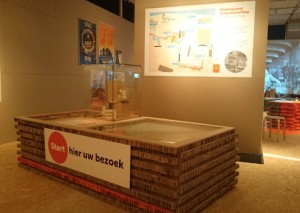While it is common for exhibitions to feature some interactive exhibit, it is often a standalone component of the exhibition. This case study addresses the challenge of co-designing interactive components so that they are fully integrated into the entire exhibition. The design of the interactive components of the exhibition, “The Hague and the Atlantic Wall: War in the City of Peace”, at Museon in the Hague, was the result of a process of co-design that took place over several months. Designers brainstormed with cultural heritage professionals (curators and technicians) to develop the interactional experience to be offered to visitors and to seamlessly integrate smart replicas with the rest of the exhibition design.
 The result of the co-design process was the creation of smart replicas as a means of adding an additional content layer that complemented the traditional, factual information that is generally provided about objects in a museum. Visitors are asked to choose a replica at the start of the exhibition, based on their preferred perspective and language. This object is then used to activate content, allowing the visitor to explore the exhibition from a single overarching perspective. The intention is that the process of choosing a replica (and its related perspective) makes visitors more curious and as a result, they have a stronger involvement with the story being told than would be the case with the use of buttons throughout the exhibition. As part of an evaluation of the exhibition, interviews were carried out with the museum’s visitors so as to receive feedback on the replicas.
The result of the co-design process was the creation of smart replicas as a means of adding an additional content layer that complemented the traditional, factual information that is generally provided about objects in a museum. Visitors are asked to choose a replica at the start of the exhibition, based on their preferred perspective and language. This object is then used to activate content, allowing the visitor to explore the exhibition from a single overarching perspective. The intention is that the process of choosing a replica (and its related perspective) makes visitors more curious and as a result, they have a stronger involvement with the story being told than would be the case with the use of buttons throughout the exhibition. As part of an evaluation of the exhibition, interviews were carried out with the museum’s visitors so as to receive feedback on the replicas.
 The smart replicas for the Atlantic Wall exhibition
The smart replicas for the Atlantic Wall exhibition
Additional Information
On the meSch blog, you can find more details on how we integrated the meSch technology in the exhibition, the use of the smart replicas, earpieces and projections connected to the exhibits in the case, personalised souvenirs and the visitor reaction to the additional layers contributed by the meSch technology to the Atlantic Wall exhibition.
Cultural Heritage Professional Testimonial:
“I feel like working with the meSch designers, listening to them, discussing and being around them has really helped me think about issues and come up with my own creative ideas because that’s really a skill that we are not trained in. It feels like sometimes it’s expected of us but as a cultural heritage professional, we write text labels! But we need to get to that stage where we can come up with our own ideas, and think of different types of content.”



